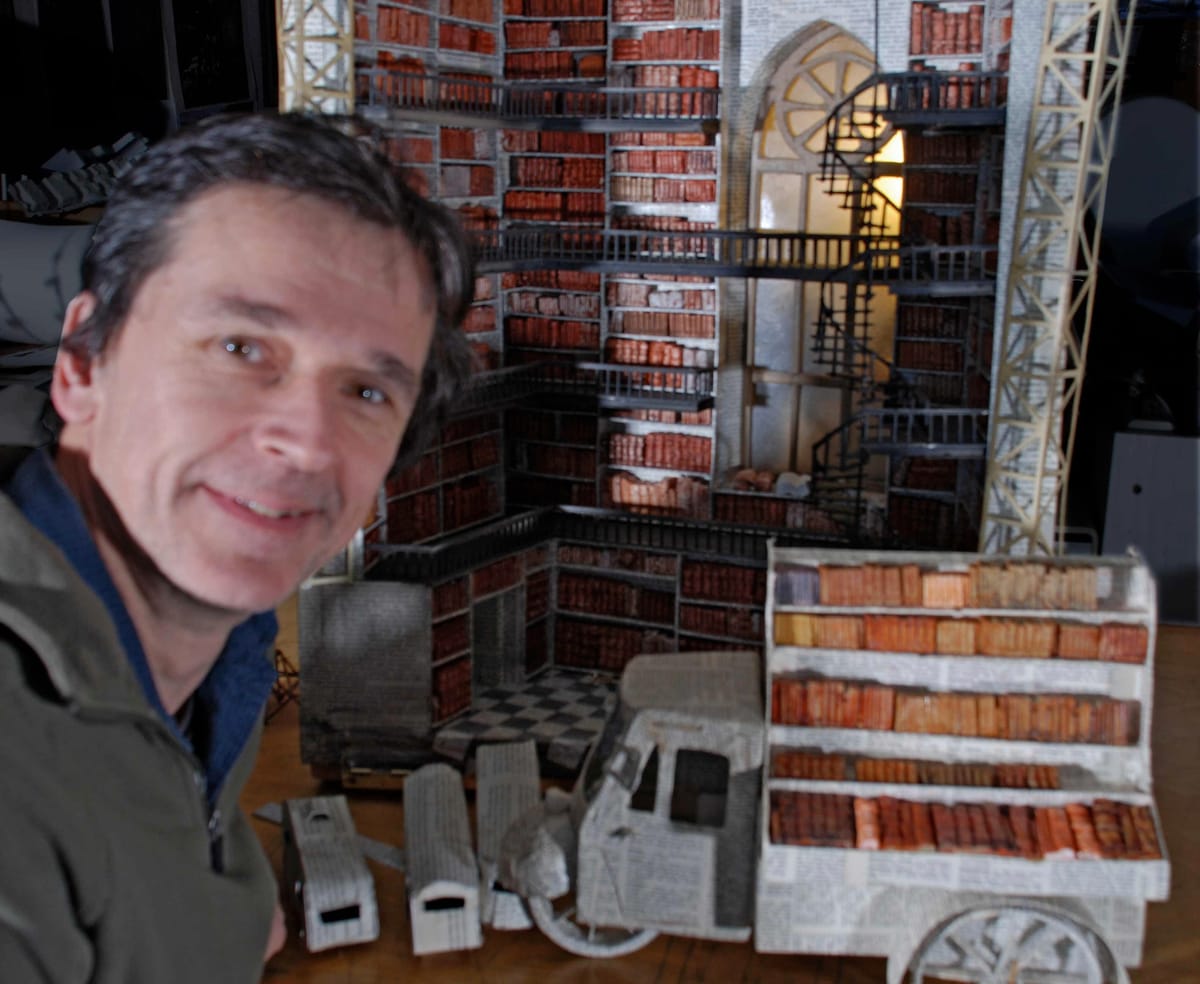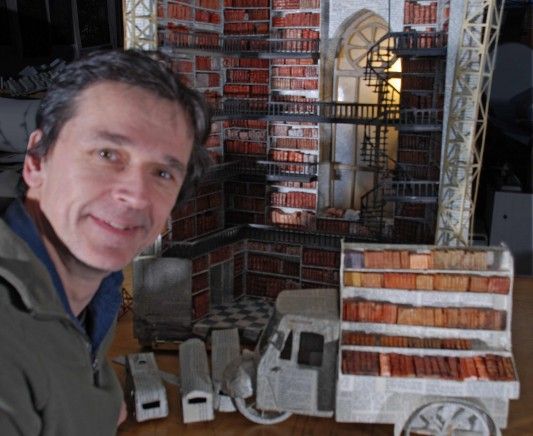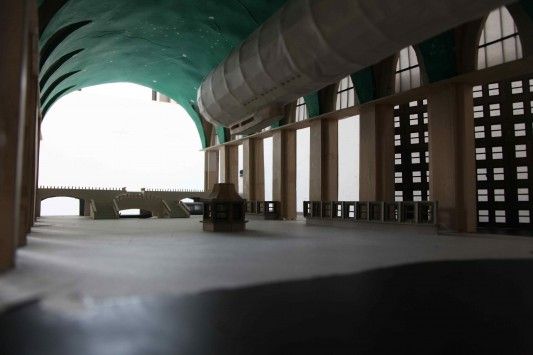Artist Lothar Osterburg Creates “Zeppelins in Grand Central”


You may have spotted the newest Arts for Transit poster on the subways recently, but did you know that the man behind the work is a South Slope neighbor?
Lothar Osterburg, who moved to 14th Street in 1996, has created a magnificent example of photogravure called “Zeppelins in Grand Central” that will be on display through 2013, in honor of Grand Central Terminal’s centennial celebration.
We sat down with Lothar to learn a bit more about the photogravure process, and his inspiration for the Arts for Transit piece.

What is photogravure?
Copperplate Photogravure is a 19th century continuous tone photographic process in which a photograph is etched into a copper plate and printed like and etching, invented by Fox Talbot in the 1840’s. Tonalities are created by an ink layer of varying depth. This is achieved by etching the plate gradually from the deepest shadows to the brightest highlights. A very fine dust grain aquatint, fine enough to disappear in the texture of the paper it’s printed on, holds the ink. Thus, photogravure is capable of producing a much wider range of tones than any other photographic process, from deep, velvety black to bright, sensitive highlights. Paul Strand considered photogravure perfectly suited for his work because of the technique’s capacity to achieve the “almost infinite tonal values which lie beyond the human hand.
In almost all other photographic printing techniques, such as photo etching, photo litho or silkcreen, the image is broken up into dots of various sizes or concentrations, with each dot printed in an equally dense black. The image only appears darker or lighter depending on the proportion of the white paper covered by black ink.
How did you come to be involved in this form of art?
I was a printmaker since art school in Germany and worked as a master printer at Crown Point Press in San Francisco when in 1989 I started learning the photogravure process for the portfolio “Gymnasium Chases” by Christian Boltanski. Fascinated by the process I started making my own photogravures, and have not stopped since.

You created an amazing model of Grand Central Terminal. Can you tell us a bit about the modeling process?
I work from memory, rebuilding scenes that have captured my imagination and keep re-surfacing. Sources are primarily personal experiences but are heavily influenced by visualized literature, art history and popular culture. These composite images have been filtered and idealized through time, becoming progressively stripped of superfluous detail.
To capture what is often initially a fleeting impression, I work quickly and intuitively, building or sculpting small-scale models by hand from memory with readily available, found materials. After staging a scene through the same intuitive process, I photograph with an extremely short focal range to simplify and soften the images.
The 19th-century photogravure process, prevalent in my work, with its rich, velvety blacks and soft, infinite gray values, is an ideal medium. The soft focus, the scratches and traces from the photogravure process, and the use of rough and unfinished models all work together to suspend the final image somewhere between the real and the imaginary.
In my new work I not only build with found materials, but also reuse and recycle my own sculptures, plates and prints in a constant rebuilding of an imaginary world formed by glimpses of the past. The process of creating this world is much like the constant transformation that New York undergoes as a city.
How long did it take to complete the photogravure?
The building process was the longest. I started working on the model on and off since early August, and finally photographed the first scene in late October. It took several photo shoots over the next few weeks and required some re-building and adding of detail until I was happy. In the end the photogravure itself took only about 2 weeks to make and print.
Did you choose Grand Central as a subject because of the upcoming anniversary, or have you always been interested in the building?
Yes, I initially was invited to participate in the show “On Time, Grand Central at 100” which opens in March. The invitation for the art card was a result from the work I had started for that show.
I have been working on this subject for a while already. I received a Guggenheim Fellowship in 2010 for a project in which I am looking at New York like (Giovanni Battista) Piranesi looked at Rome in his “Carceri” series. I am looking at the city in which I have been living for the past 20 years with the eyes of an immigrant, as the city that is grander from afar than it really is, a city that is rooted in its own glorified past, potential and myths.
I am imagining how New York would look like if history had taken a different turn sometime in the past. I am imagining how New York’s landmarks will be re-purposed in the future, just like the colosseum in Rome was stripped, became a cemetery, and accommodated stables, housing, workshops and churches before becoming a modern tourist attraction.
We love how the image melds fiction and reality so seamlessly. It’s almost as if the zeppelins are supposed to be there. What was your inspiration for using the great ships?
The inspiration came less from the coincidental birth of Airships and Grand Central Terminal around the same time, but more from photographs of their heydays in the 1920’s and 30’s, including the fictitious docking of a Zeppelin at the Empire State building, currently on view at the show “Faking it” at the MET.
I had been working with Zeppelins on other projects before, and just happened to place one on the model when working on the Grand Central project for the show “On Time, Grand Central at 100” to which I had been invited. The scale of an airship hangar has always fascinated me, and building the grand concourse model made me think of it.
I was thinking of Grand Central Terminal not as a static place with static purpose, but as one that like roman ruins would be re-purposed in the future. Rather than letting it fall into ruin I thought it would make a great transfer point for local, or even mid to long range Zeppelins – much more convenient than JFK.
In the end one could look at the scene either as a visionary in 1913 imagined Grand Central to look like in 1984, or how the March 2513 issue of National Geographic illustrated the possible 20th century activities on the site Grand Central after an archeological dig.
How is an Arts for Transit piece chosen?
I got lucky that Amy Hausmann from MTA Arts for Transit saw my Show “Yesterday’s City of Tomorrow” at Lesley Heller Gallery last February and contacted me after that.
Are the prints available for purchase?
Yes the posters are for sale at the New York Transit Museum Gift store at Grand Central Terminal or online at www.transitmuseumstore.com Item # 34516 .
How long will it be on display?
The Art Card will be on view for one year and they are being changed right now. There are 2 art cards in total, the other one is by Marcos Chin. I have yet to see mine in the subway.
Do you offer lessons on the photogravure process at your studio?
I teach about 4 workshops a year in my studio and a few more in other places, through I don’t advertise them publicly. Artists and photographers find me word to mouth or through my website. I send e-mail announcements to everyone who is interested.
Images via Lothar Osterburg




